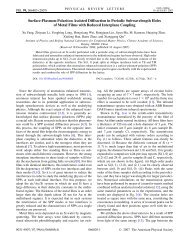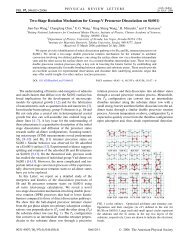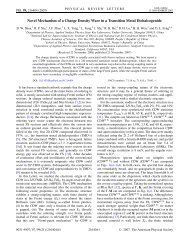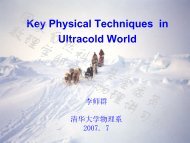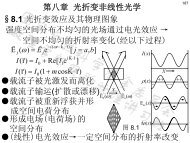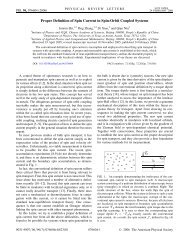Fluorescence Quenching in a Perylenetetracarboxylic Diimide Trimer
Fluorescence Quenching in a Perylenetetracarboxylic Diimide Trimer
Fluorescence Quenching in a Perylenetetracarboxylic Diimide Trimer
Create successful ePaper yourself
Turn your PDF publications into a flip-book with our unique Google optimized e-Paper software.
Communication<br />
Subscriber access provided by INSTITUTE OF PHYSICS<br />
<strong>Fluorescence</strong> <strong>Quench<strong>in</strong>g</strong> <strong>in</strong> a <strong>Perylenetetracarboxylic</strong> <strong>Diimide</strong> <strong>Trimer</strong><br />
Yanfeng Wang, Hailong Chen, Haixia Wu, Xiyou Li, and Yuxiang Weng<br />
J. Am. Chem. Soc., 2009, 131 (1), 30-31 • DOI: 10.1021/ja8072116 • Publication Date (Web): 15 December 2008<br />
More About This Article<br />
Downloaded from http://pubs.acs.org on February 4, 2009<br />
Additional resources and features associated with this article are available with<strong>in</strong> the HTML version:<br />
• Support<strong>in</strong>g Information<br />
• Access to high resolution figures<br />
• L<strong>in</strong>ks to articles and content related to this article<br />
• Copyright permission to reproduce figures and/or text from this article<br />
Journal of the American Chemical Society is published by the American Chemical<br />
Society. 1155 Sixteenth Street N.W., Wash<strong>in</strong>gton, DC 20036
<strong>Fluorescence</strong> <strong>Quench<strong>in</strong>g</strong> <strong>in</strong> a <strong>Perylenetetracarboxylic</strong> <strong>Diimide</strong> <strong>Trimer</strong><br />
Yanfeng Wang, † Hailong Chen, ‡ Haixia Wu, † Xiyou Li,* ,† and Yuxiang Weng* ,‡<br />
Department of Chemistry, Shandong UniVersity, J<strong>in</strong>an, Shandong 250100, Ch<strong>in</strong>a, and Institute of Physics, Ch<strong>in</strong>ese<br />
Academy of Science, Beij<strong>in</strong>g 100080, Ch<strong>in</strong>a<br />
Received September 11, 2008; E-mail: xiyouli@sdu.edu.cn; yxweng@aphy.iphy.ac.cn<br />
Energy transfer (ET) and migration <strong>in</strong> natural light harvest<strong>in</strong>g<br />
systems (LHs) are highly efficient despite <strong>in</strong>volv<strong>in</strong>g complex<br />
structures with many different chlorophyll molecules. 1 Great efforts<br />
have been devoted to the synthesis and characterization of artificial<br />
systems that can elucidate or mimic key mechanisms of ET <strong>in</strong><br />
natural LHs. 2 Recently the ET <strong>in</strong> more complicated systems, such<br />
as molecular aggregates with precisely controlled structure, has<br />
generated a lot of <strong>in</strong>terest because the crystal structure of LHs has<br />
revealed the dom<strong>in</strong>at<strong>in</strong>g role of aggregated bacterio-chlorophylls<br />
(BChl) <strong>in</strong> the ET process <strong>in</strong> photosynthesis. 2c,3<br />
To understand the photophysical properties of molecular aggregates,<br />
the study on the photophysical <strong>in</strong>teractions between<br />
monomeric and aggregated molecules is necessary because the selfaggregation<br />
normally leads to equilibrium between aggregates and<br />
monomeric molecules <strong>in</strong> solution. An energy transfer from a<br />
diphenylacetylene monomer to dimer has recently been reported<br />
<strong>in</strong> a DNA triplex templated supramolecular system, 4 but the<br />
dynamics and the efficiency of this ET are still unknown. To<br />
elucidate the detail of the ET from monomer to dimer, new models<br />
with relative simple but well-def<strong>in</strong>ed structure are necessary. We<br />
designed a trimeric perylenetetracarboxylic diimide (PDI) molecule,<br />
with three PDI molecules connected by a melam<strong>in</strong>e, 3 <strong>in</strong> Figure 1.<br />
Figure 1. Molecular structures of the compounds.<br />
Because the face-to-face structure formed by the two chromophores<br />
l<strong>in</strong>ked by melam<strong>in</strong>e has been well documented <strong>in</strong> literature, 5 we<br />
expect a face-to-face dimeric conformation for two of the three<br />
PDIs <strong>in</strong> the molecule; the third one appended acts as a monomer,<br />
which partially resembles the structural block <strong>in</strong> the LH2 complex,<br />
that is, B800 BChl monomer and B850 BChl dimer. 1b Our design<br />
is structurally different from the flexible l<strong>in</strong>ear PDI trimer 6 as well<br />
as the rigid cofacially stacked PDI trimer 7 and should be an ideal<br />
model for the study of the photophysical <strong>in</strong>teractions between a<br />
covalently l<strong>in</strong>ked monomer and dimer.<br />
† Shandong University.<br />
‡ Institute of Physics, CAS.<br />
30 9 J. AM. CHEM. SOC. 2009, 131, 30–31<br />
Published on Web 12/15/2008<br />
Compound 3 together with monomer 1 and dimer 2 were<br />
prepared by the condensation of 1,7-di(4′-t-butyl)phenoxy-perylene-<br />
9,10-(N-hexyl)-dicarboxyimide-3,4-dicarboxylic anhydride with<br />
correspond<strong>in</strong>g melam<strong>in</strong>e derivatives. 8 The synthesis and structure<br />
characterization are described <strong>in</strong> the Support<strong>in</strong>g Information.<br />
The absorption spectra of compounds 1-3 show two <strong>in</strong>tense<br />
absorption bands peaked at about 502 and 542 nm, but with varied<br />
relative <strong>in</strong>tensity between these two peaks (Figure 2). Apparently<br />
Figure 2. UV-vis absorption and fluorescence spectra of monomer 1 (∆),<br />
dimer 2 (O), and trimer 3 (9) <strong>in</strong> toluene.<br />
the relative peak-<strong>in</strong>tensity of the dimer 2 is reversed from that of<br />
the monomer 1. This <strong>in</strong>tensity revers<strong>in</strong>g can be attributed to the<br />
formation of a face-to-face stacked PDI dimer. 6 It is noteworthy<br />
that the absorption spectrum of compound 3 presents two peaks<br />
with almost equal <strong>in</strong>tensity and is concentration <strong>in</strong>dependent <strong>in</strong> the<br />
range of 10 -4 -10 -6 mol L -1 , <strong>in</strong>dicat<strong>in</strong>g that the peak at 502 nm is<br />
not due to the <strong>in</strong>termolecular aggregation, but a <strong>in</strong>tramolecular<br />
aggregation <strong>in</strong>stead. More <strong>in</strong>terest<strong>in</strong>gly, the spectrum of compound<br />
3 is almost identical to the sum of that of 1 and 2, which suggests<br />
that compound 3 is composed of a “dimer” and a “monomer” as<br />
expected, and there is no significant <strong>in</strong>teractions between them at<br />
ground state. This is also supported by the 1 H NMR spectra of 1,<br />
2 and 3 (Figure S2 <strong>in</strong> Support<strong>in</strong>g Information).<br />
The monomer’s emission is observed at 570 nm with a lifetime<br />
of 4.5 ns while the dimer 2 shows monomer’s emission at 570 nm<br />
with a broad tail extend<strong>in</strong>g to 750 nm (Figure 2). The tail with a<br />
lifetime of 20 ns can be assigned to the excimer’s emission from<br />
the face-to-face stacked PDI dimer. 8 The overall fluorescence<br />
quantum yield for dimer 2 (8%) is much smaller than that of the<br />
monomer. 2a On the basis of the results of absorption and fluorescence<br />
spectra of compound 3, one would expect a very strong<br />
monomer’s emission from compound 3. However, compound 3<br />
gives a broad emission band <strong>in</strong> the range of 550-750 nm with a<br />
fluorescence lifetime of 22 ns, typical of the excimer’s emission<br />
rather than that of monomer. 9 This <strong>in</strong>dicates that the fluorescence<br />
10.1021/ja8072116 CCC: $40.75 © 2009 American Chemical Society
of monomer has been quenched. The excitation spectra of compound<br />
3 (Figure S3), showed clearly the contributions of the<br />
monomer’s absorption at 542 nm to the emission of dimer at 650<br />
nm, suggest<strong>in</strong>g the presence of ET from monomer to dimer <strong>in</strong> 3. It<br />
is worth not<strong>in</strong>g that the similar strong excimer-like emission has<br />
also been found for a rigid cofacially stacked PDI trimer with strong<br />
ground-state <strong>in</strong>teractions among the three PDI units. 7 The emission<br />
properties of 3 suggest that the excimer-like emission of PDI trimer<br />
can also be achieved by a photo<strong>in</strong>duced energy transfer between<br />
non<strong>in</strong>teracted monomer and dimer.<br />
To ga<strong>in</strong> an <strong>in</strong>sight <strong>in</strong>to the ET from monomer to dimer <strong>in</strong><br />
compound 3, time-resolved transient absorption spectra were<br />
recorded 10 (Figure S4). Samples were excited at 400 nm (150 fs <strong>in</strong><br />
pulse width). In compound 3, both the monomeric and dimeric<br />
subunits would be excited simultaneously, and we employed the<br />
method of s<strong>in</strong>gular value decomposition (SVD) comb<strong>in</strong>ed with<br />
global fitt<strong>in</strong>g procedure to resolve the absorption spectra of the<br />
related species and the correspond<strong>in</strong>g k<strong>in</strong>etics based on a proposed<br />
monomeric/dimeric coexcitation model 10a (Figure 3A). This model<br />
Figure 3. (A) Model for energy relaxation and transfer <strong>in</strong> the trimer where<br />
the monomeric and dimeric subunits are coexcited: (left) dimeric excitation<br />
path; (right) monomeric excitation path. Dn (n ) 0-2) ) energy levels of<br />
the dimer, where D1 and D2 arise from the energy splitt<strong>in</strong>g of the monomeric<br />
level because of the formation of H aggregates; Mn (n ) 0-2) ) energy<br />
levels of monomer; E1 ) the lowest excited energy level of the excimer.<br />
Panels B, C, and D show the species associated spectra (SAS) obta<strong>in</strong>ed by<br />
s<strong>in</strong>gular value decomposition (SVD) together with global fitt<strong>in</strong>g with the<br />
coexcitation model (B, dimer; C, monomer; D, excimer). Graphic <strong>in</strong>set:<br />
the associated population evolution curve of the three components.<br />
<strong>in</strong>volves a s<strong>in</strong>gle photon excitation of both the monomeric and<br />
dimeric subunits with different probability, followed by different<br />
energy relaxation paths as shown <strong>in</strong> Figure 3A. In this model the<br />
fast energy relax<strong>in</strong>g from M2 to M1 and the fluorescence from M1<br />
to M0 of low quantum efficiency are ignored. The excitation<br />
probability ratio for these two branches is obta<strong>in</strong>ed as a fitt<strong>in</strong>g<br />
parameter <strong>in</strong> the model.<br />
We obta<strong>in</strong>ed three major components correspond<strong>in</strong>g to monomeric,<br />
dimeric, and excimeric subunits <strong>in</strong> the resolved transient<br />
absorption spectra <strong>in</strong> terms of the coexcitation model. The resolved<br />
species associated spectra (SAS) and the associated temporal profile<br />
(C(t)) 10a are shown <strong>in</strong> Figure 3. The <strong>in</strong>verted bleach<strong>in</strong>g spectra of<br />
monomeric and dimeric units are comparable to the absorption<br />
spectra of the correspond<strong>in</strong>g monomer and dimer. The lifetime for<br />
energy relaxation from the dimer to the excimer is 4.5 ps, while<br />
the ET from the monomer to the excimer is 0.8 ps, which is similar<br />
to that of B800 to B850 (0.8-0.9 ps). 10b The obta<strong>in</strong>ed excitation<br />
probability ratio for the dimeric and monomeric unit is 1.5, which<br />
is same as the ratio of the ext<strong>in</strong>ction coefficiencies of monomer 1<br />
and dimer 2 at the excitation wavelength.<br />
In conclusion, we have demonstrated for the first time that the<br />
fluorescence of a monomeric PDI can be quenched by a covalently<br />
l<strong>in</strong>ked PDI dimer. Both the excitation and transient absorption<br />
spectra support that the efficient and ultrafast ET from PDI<br />
monomer to dimer is responsible for this fluorescence quench<strong>in</strong>g.<br />
Our f<strong>in</strong>d<strong>in</strong>g suggests that the ET can happen efficiently and quickly<br />
between a pair of non<strong>in</strong>teracted PDI monomer and dimer. We<br />
believe that this observation is mean<strong>in</strong>gful for the design and<br />
construction of novel artificial LH systems.<br />
Acknowledgment. The f<strong>in</strong>ancial support from NSFC (Grant No.<br />
20571049, 20610467, 20771066), M<strong>in</strong>istry of Education of Ch<strong>in</strong>a<br />
(Grant No. 070422040), and Shandong University are acknowledged.<br />
Support<strong>in</strong>g Information Available: Details of the synthesis, the<br />
1 H NMR spectra, results of elemental analysis, the absorption spectra<br />
of 3 <strong>in</strong> dichloromethane with different concentrations, the excitation<br />
spectra of 3. This material is available free of charge via the Internet<br />
at http://pubs.acs.org.<br />
References<br />
(1) (a) Hu, X.; Schulten, K. Phys. Today 1997, 29–34. (b) McLuskey, K.;<br />
Pr<strong>in</strong>ce, S. M.; Cogdell, R. J.; Isaacs, N. W. Biochemistry 2001, 40, 8783–<br />
8789. (c) McDermott, G.; Pr<strong>in</strong>ce, S. M.; Freer, A. A.; Hawthornthwaite-<br />
Lawless, A. M.; Papiz, M. Z.; Cogdell, R. J.; Isaacs, N. W. Nature 1995,<br />
374, 517–521.<br />
(2) (a) Wasielewski, M. R. J. Org. Chem. 2006, 71, 5051–5066. (b) Gust, D.;<br />
Moore, T. A.; Moore, A. L. Acc. Chem. Res. 2001, 34, 40–48. (c) Kim,<br />
D.; Osuka, A. Acc. Chem. Res. 2004, 37, 735–744.<br />
(3) Some representative works: (a) Huiiser, A.; Savenijie, T. J.; Kotlewski,<br />
A.; Picken, S. J.; Siebbeles, L. D. A. AdV. Mater. 2006, 18, 2234–2239.<br />
(b) Hoeben, F. J. M.; Shklyarevskiy, I. O.; Pouderoijen, M. J.; Engelkamp,<br />
H.; Schenn<strong>in</strong>g, A. P. H. J.; Christianen, P. C. M.; Maan, J. C.; Meijer,<br />
E. W. Angew. Chem., Int. Ed. 2006, 45, 1232–1236. (d) Li, X.; S<strong>in</strong>ks,<br />
L. E.; Rybtch<strong>in</strong>ski, B.; Wasielewski, M. R. J. Am. Chem. Soc. 2004, 126,<br />
10810–10811.<br />
(4) Lets<strong>in</strong>ger, R. L.; Wu, T.; Yang, J.-S.; Lewis, F. D. Photochem. Photobiol.<br />
Sci. 2008, 7, 854–859.<br />
(5) (a) Whitesides, G. M.; Simanek, E. E.; Mathias, J. P.; Seto, C. T.; Ch<strong>in</strong>,<br />
D. N.; Mammen, M.; Gordon, D. M. Acc. Chem. Res. 1995, 28, 37–44. (b)<br />
Seto, C. T.; Whitesides, G. M. J. Am. Chem. Soc. 1993, 115, 905–906. (c)<br />
Whitesides, G. M.; Mathias, J. P.; Simanek, E. E. J. Am. Chem. Soc. 1994,<br />
116, 4326–4330. (d) Mammen, M.; Simanek, E. E.; Whitesides, G. M.<br />
J. Am. Chem. Soc. 1996, 118, 12614–12623. (e) Ishi-i, T.; Crego-Calama,<br />
M.; Timmerman, P.; Re<strong>in</strong>houdt, D. N.; Sh<strong>in</strong>kai, S. J. Am. Chem. Soc. 2002,<br />
124, 14631–14641.<br />
(6) Han, J.; Wang, W.; Li, A. D. Q. J. Am. Chem. Soc. 2006, 128, 672–673.<br />
(7) Giaimo, J. M.; Lockard, J. V.; S<strong>in</strong>ks, L. E.; Scott, A. M.; Wilson, T. M.;<br />
Wasielewski, M. R. J. Phys. Chem. A 2008, 112, 2322–2330.<br />
(8) Wang, Y.; Chen, Y.; Li, R.; Wang, S.; Su, W.; Ma, P.; Wasielewski, M. R.;<br />
Li, X.; Jiang, J. Langmuir 2007, 23, 5836–5842.<br />
(9) (a) Rybtch<strong>in</strong>ski, B.; S<strong>in</strong>ks, L. E.; Wasielewski, M. R. J. Am. Chem. Soc.<br />
2004, 126, 12268–12269. (b) Wang, W.; Wan, W.; Zhou, H. H.; Niu, S.;<br />
Li, A. D. Q. J. Am. Chem. Soc. 2003, 125, 5248–5249.<br />
(10) (a) Zhang, L.; Yang, J.; Wang, L.; Yang, G.; Weng, Y. J. Phys. Chem. B<br />
2003, 107, 13688–13697. (b) Chen, X.; Zhang, L.; Weng, Y.; Du, L.; Ye,<br />
M.; Yang, G.; Fujii, R.; Rondonuwu, F. S.; Koyama, Y.; Wu, S.; Zhang,<br />
J. Biophys. J. 2005, 88, 4262–4273.<br />
JA8072116<br />
COMMUNICATIONS<br />
J. AM. CHEM. SOC. 9 VOL. 131, NO. 1, 2009 31




